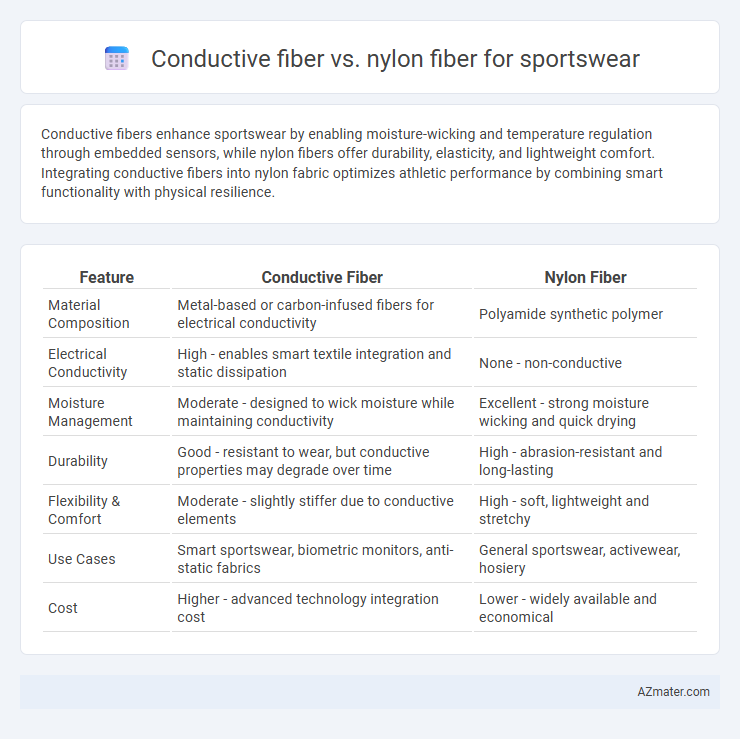Conductive fibers enhance sportswear by enabling moisture-wicking and temperature regulation through embedded sensors, while nylon fibers offer durability, elasticity, and lightweight comfort. Integrating conductive fibers into nylon fabric optimizes athletic performance by combining smart functionality with physical resilience.
Table of Comparison
| Feature | Conductive Fiber | Nylon Fiber |
|---|---|---|
| Material Composition | Metal-based or carbon-infused fibers for electrical conductivity | Polyamide synthetic polymer |
| Electrical Conductivity | High - enables smart textile integration and static dissipation | None - non-conductive |
| Moisture Management | Moderate - designed to wick moisture while maintaining conductivity | Excellent - strong moisture wicking and quick drying |
| Durability | Good - resistant to wear, but conductive properties may degrade over time | High - abrasion-resistant and long-lasting |
| Flexibility & Comfort | Moderate - slightly stiffer due to conductive elements | High - soft, lightweight and stretchy |
| Use Cases | Smart sportswear, biometric monitors, anti-static fabrics | General sportswear, activewear, hosiery |
| Cost | Higher - advanced technology integration cost | Lower - widely available and economical |
Introduction to Sportswear Fiber Technologies
Conductive fibers enhance sportswear by enabling moisture management, temperature regulation, and electronic integration for smart textiles, offering advantages in performance and comfort. Nylon fibers, known for their high durability, elasticity, and moisture-wicking properties, remain a staple in sportswear for their lightweight and breathable characteristics. Combining conductive fibers with nylon can create advanced sportswear that supports both physical activity and wearable technology functionalities.
What Are Conductive Fibers?
Conductive fibers are specialized textile materials embedded with conductive properties, often integrating metals like silver or copper to enable electrical conductivity. Unlike traditional nylon fibers used in sportswear, which primarily offer durability and moisture-wicking, conductive fibers provide advanced functionalities such as biometric sensing, temperature regulation, and enhanced anti-static performance. These innovative fibers enhance sportswear by combining fabric comfort with smart technology for improved athletic monitoring and performance.
Key Properties of Nylon Fiber
Nylon fiber is prized for its exceptional strength, elasticity, and abrasion resistance, making it highly durable for sportswear applications. Its lightweight and moisture-wicking properties enhance comfort by efficiently managing sweat and maintaining breathability during intense physical activities. The ability of nylon to blend effortlessly with other fibers, including conductive fibers, allows for innovative designs that improve both performance and functionality in athletic apparel.
Moisture-Wicking Capabilities: Conductive vs Nylon
Conductive fibers excel in moisture-wicking capabilities due to their enhanced ability to facilitate sweat evaporation through built-in conductive properties that regulate temperature and improve breathability. Nylon fibers, while durable and lightweight, typically absorb more moisture and dry slower, making them less efficient for moisture management in high-intensity sportswear applications. Sportswear incorporating conductive fibers provides superior moisture control, reducing sweat retention and enhancing comfort during vigorous physical activity.
Comfort and Breathability Comparison
Conductive fibers outperform nylon fibers in sportswear by providing superior moisture-wicking capabilities and temperature regulation, enhancing overall comfort during intense physical activity. Nylon fibers are durable and lightweight but tend to trap heat and moisture, reducing breathability compared to conductive fibers integrated with advanced materials like silver or carbon. Sportswear incorporating conductive fibers offers enhanced airflow and quicker sweat evaporation, making it ideal for maintaining optimal body temperature and comfort.
Durability in Athletic Performance
Conductive fibers offer enhanced durability in sportswear by resisting wear and tear while maintaining electrical conductivity for smart textile applications. Nylon fibers provide high tensile strength and abrasion resistance, ensuring long-lasting performance under intense physical activity. Combining conductive and nylon fibers can optimize athletic wear durability by leveraging the toughness of nylon with the functional benefits of conductivity.
Flexibility and Stretch for Movement
Conductive fibers offer superior flexibility and stretch compared to nylon fibers, enhancing unrestricted movement in sportswear by adapting to dynamic body motions. Nylon fibers provide good elasticity but often lack the advanced stretch recovery and adaptive movement capabilities found in conductive fibers. Incorporating conductive fibers in sports apparel ensures optimal comfort and performance through enhanced flexibility and stretch responsiveness.
Smart Textiles: Integrating Electronics with Clothing
Conductive fibers, such as silver-coated or carbon-based threads, enable seamless integration of sensors and electronic components into sportswear, enhancing functionalities like heart rate monitoring and muscle activity tracking. Nylon fibers, while breathable and durable, lack intrinsic conductivity and often require additional conductive materials or coatings to support electronic integration in smart textiles. The combination of conductive fibers with traditional nylon enhances the performance and comfort of smart sportswear by balancing electrical functionality with flexibility and moisture management.
Cost and Availability of Conductive and Nylon Fibers
Conductive fibers, often made from materials like carbon or metal blends, tend to be more expensive and less widely available compared to widely produced nylon fibers commonly used in sportswear. Nylon fibers benefit from large-scale manufacturing infrastructure, resulting in lower costs and consistent availability, making them a cost-effective choice for athletic apparel. Meanwhile, conductive fibers are primarily utilized in specialized performance or smart textiles where electrical conductivity is essential, limiting their mainstream market presence and increasing production costs.
Choosing the Right Fiber for Your Sportswear Needs
Conductive fiber enhances sportswear with superior moisture-wicking and antimicrobial properties, making it ideal for high-performance activities requiring temperature regulation and odor control. Nylon fiber offers excellent durability, elasticity, and abrasion resistance, providing long-lasting comfort and flexibility for varied sports and workouts. Choosing between conductive and nylon fibers depends on prioritizing performance features like breathability and conductivity versus strength and stretch tailored to specific athletic demands.

Infographic: Conductive fiber vs Nylon fiber for Sportswear
 azmater.com
azmater.com